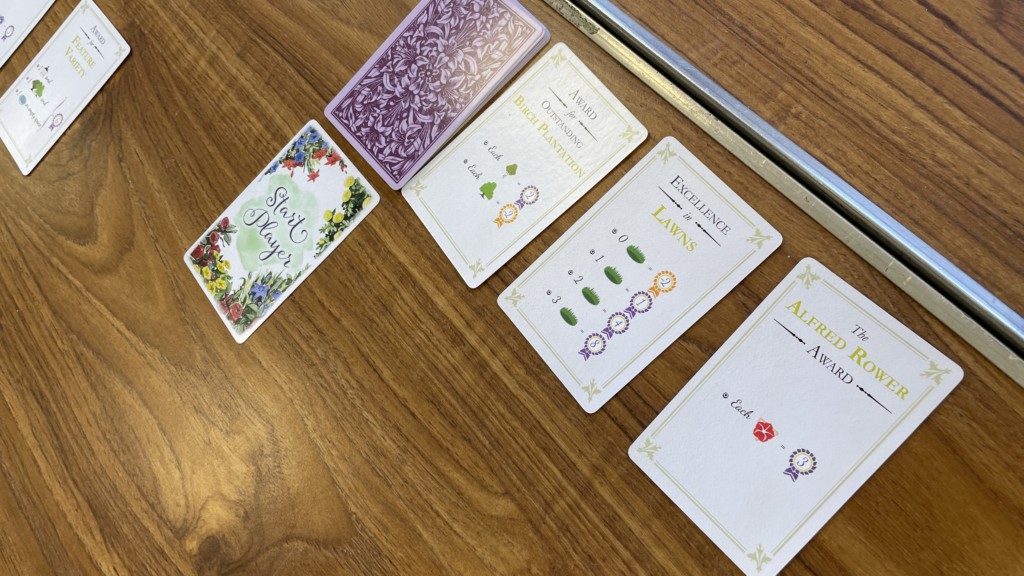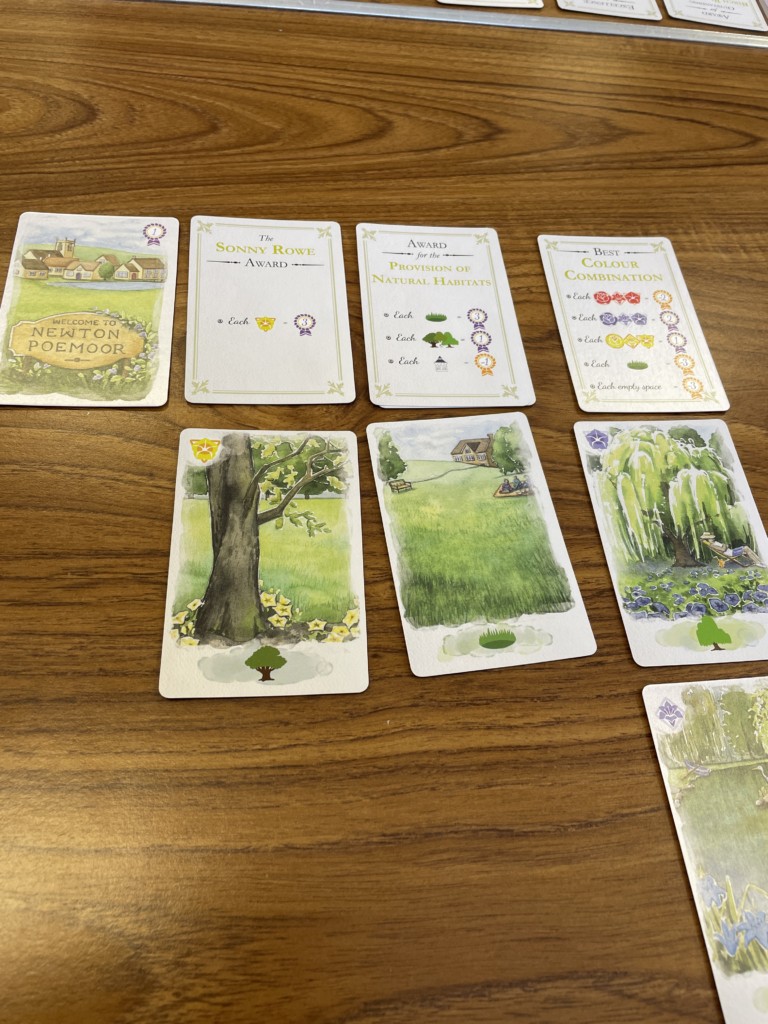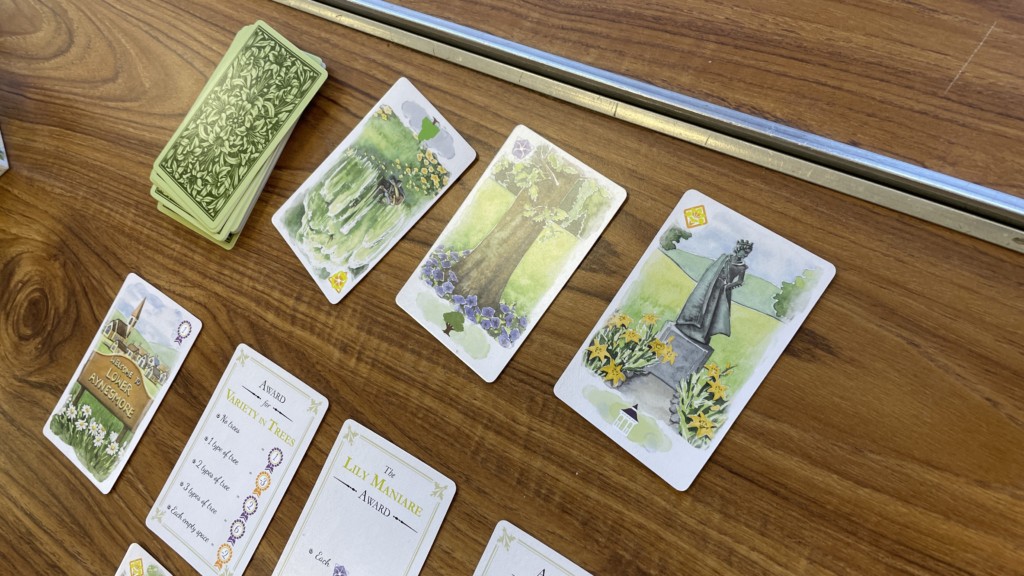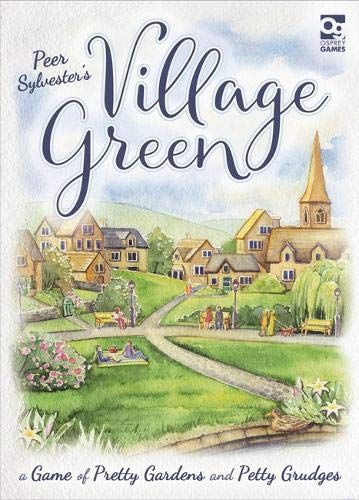Village Green First Impressions
In Village Green, players are building out the most beautiful village green they can.
But how do you judge beauty? Well, that can change from turn to turn.
It’s the first day of spring, and there’s only one thing on everyone’s mind — the Village Green of the Year competition! In just a few months, the judges of this prestigious contest will be visiting, and the village council have finally put you in charge of the preparations.
Village Green Game Play
Each player gets a card showing the name of their village green.
The Award card deck is shuffled and 3 are dealt to each player. These are placed in a face-up row next to the village card. Three more award cards are placed next to the deck face-up.

The Green cards are shuffled and 3 are dealt to each player face-down and three are placed face-up next to the deck.
Starting with the start player and going clockwise, players take turns taking one of two actions.
Draw & Play a Green Card
Players take a face-up Green card from the table, put it in their hand and replace the taken card or they can take one from the top of the deck.
Then, the player may place a green card from their hand into their village. If one isn’t placed, one is put on the bottom of the deck instead.
A village is made up of a 4×4 grid with the top row and left column displaying the Award cards and the village card in the top left. The remaining 3×3 grid is made of Green cards.
Most Green cards have flowers on them: roses, petunias, or lilies in red, blue, or yellow. When you place a green card, it must match each adjacent green card by flower type, flower colour, or both.
Green cards also have other features. Tree cards have various numbers of oak, birch, or willow. Structures, when played, make you immediately draw and play an award card. Ponds in your village are worth two points at the end of the game.
Lawn cards have no flowers on them so can be played next to any card. You may also place Green cards on top of a lawn card as long as the newly placed card follows all the placement rules.

Draw & Play an Award Card
Players take a face-up Award card from the table or one from the top of the deck. This card must be placed in the village.
These can only be placed in the top row or the leftmost column of your village but award cards can always be placed on top of another Award card.
For each Award card in your top row, you score based on the green cards in that column. For each award card in your leftmost column, you score based on the green cards in that row.
Once per game before taking an action, a player may flip their village card face down to take a special action. These are to replace the 3 available face-up Green or Award cards on the table or take the ‘draw and play a Geen card’ action placing the new card on top of another green card
Game End
The game ends when a player has filled all 9 slots in their village or either deck is empty.
Even turns are played then players score.
You get one point if your village card is face-up, two points for every pond and then the score of each reward card. The player with the most points wins with a tie going to the player with the most visible green cards in the village.
Theme
I like village greens, especially where there is a cricket pitch or a pond/lake in them. There are plenty of really nice ones where I live in the midlands so I don’t mind this theme at all.
Setup
Shuffle and deal as always the best setup.
Components & Artwork
The cards are pretty standard but the artwork is really pleasant.

Ease of Teaching
It’s easy to teach, however, we did have the rulebook out a lot while playing. I’m not sure if the copy I played was an older version or something but the PDF of the rules I found are 10x clearer than the ones I read on the day.
Village Green Summary
For similar games, there aren’t too many like it that I’ve played so I’ll just give a nod to Topiary as you’re building a garden there too.
So this is basically a tableau-building game if you boil it down to its core bit. You’re playing these cards into your grid to score them.
But you don’t exactly know what you’re scoring. You might have the perfect column but does it mean those cards will score well in their relevant row?
Well, that’s a problem.
Not only in the tricky gameplay, but also in scoring. I didn’t add any row scoring at all. I spent all my time getting a perfect 9 cards in my original 3 scoring columns and that’s all I needed to win.
But I think playing with experienced players you won’t be able to win focusing on getting a quick 9 card out as I did.
So overall it’s a really nice, fairly relaxing game. I say fairly because as with any game where you draft cards someone will inevitably take the one you needed!
But you don’t want it to be too relaxing do you? 🙂
Jesta ThaRogue

